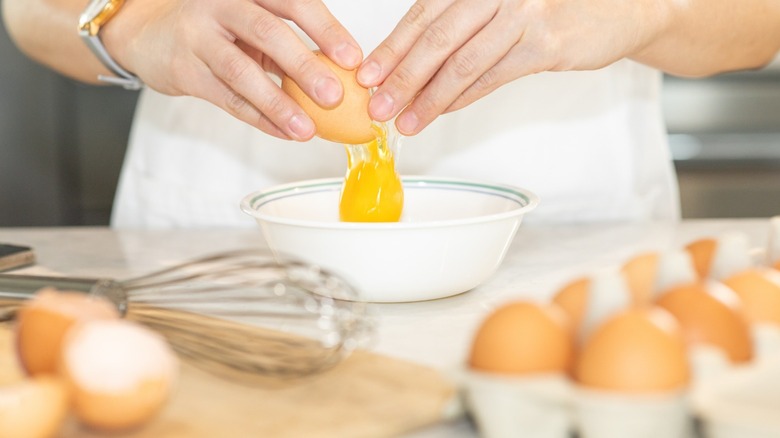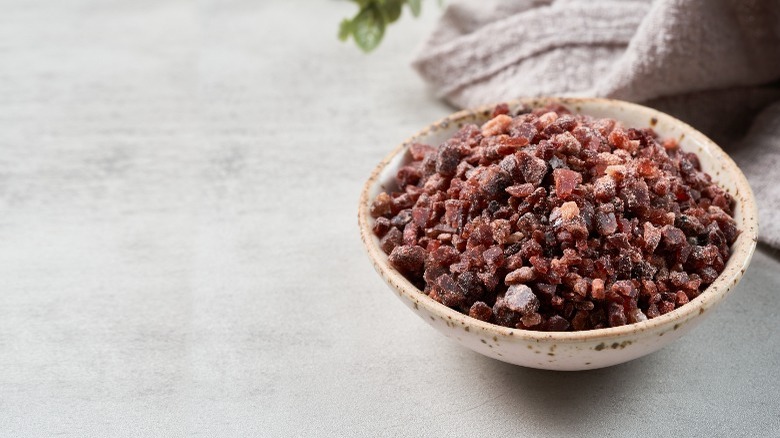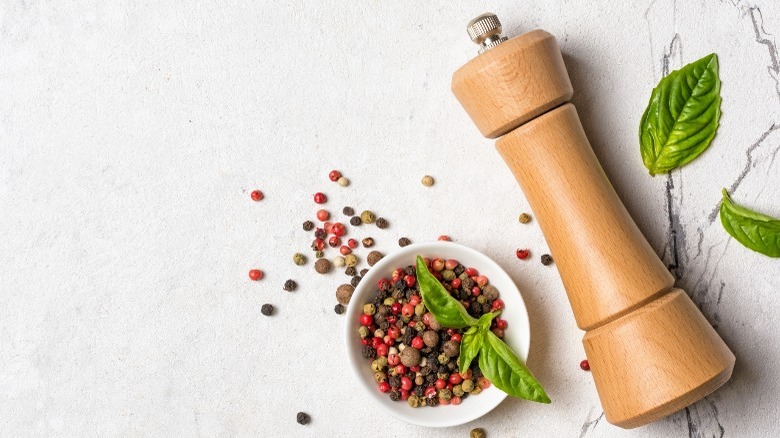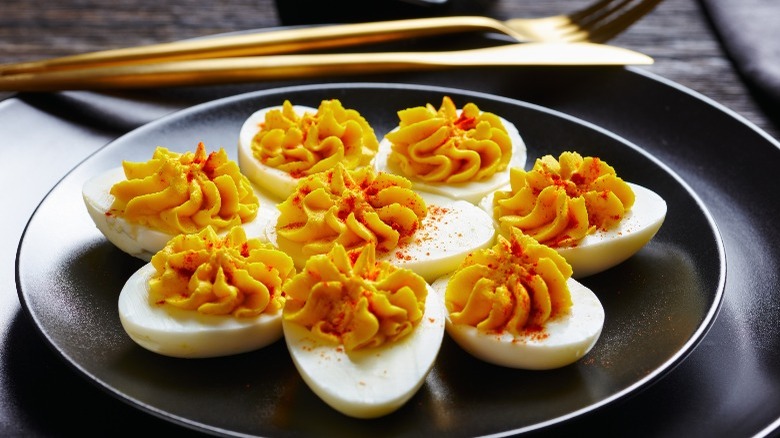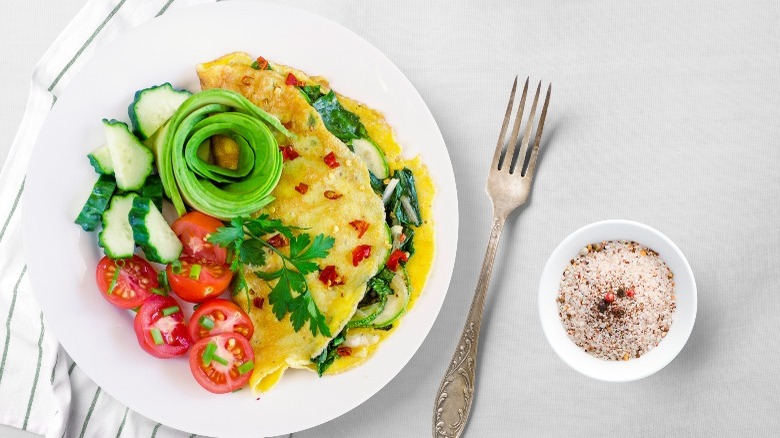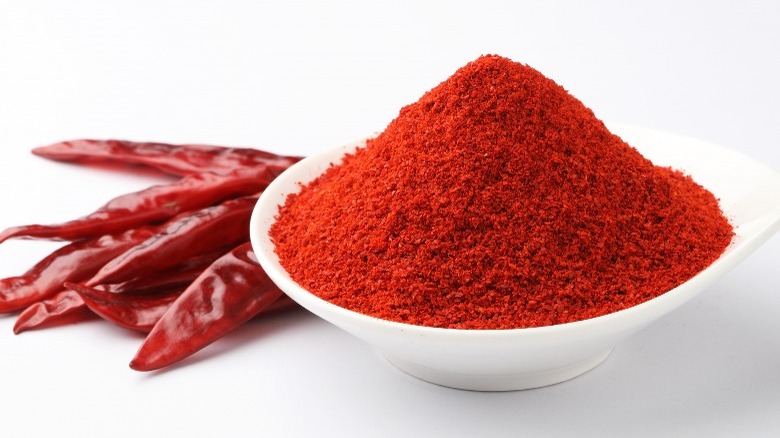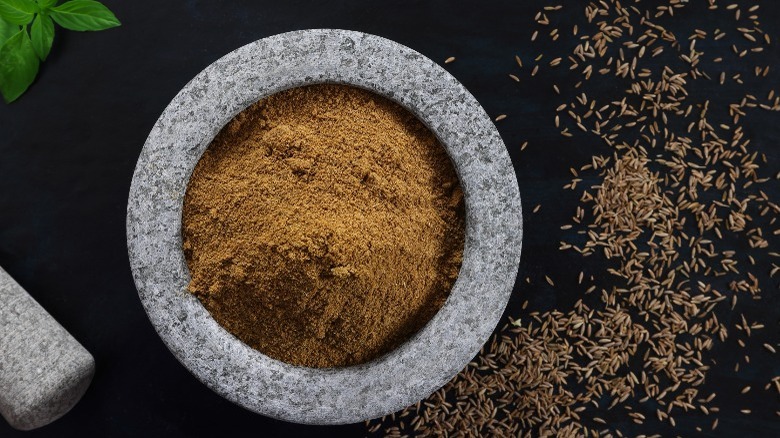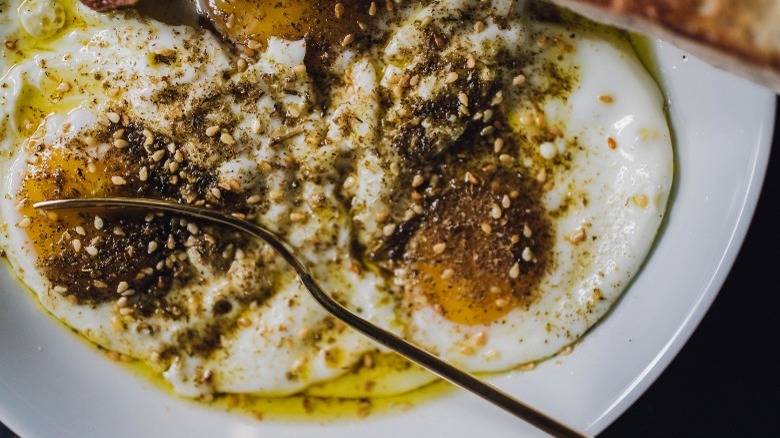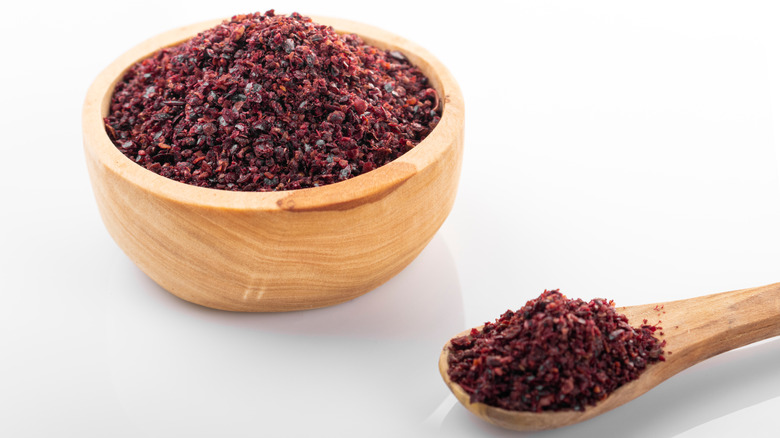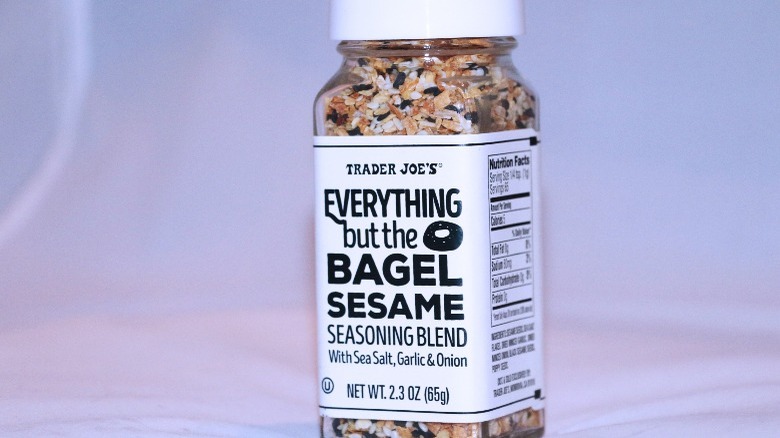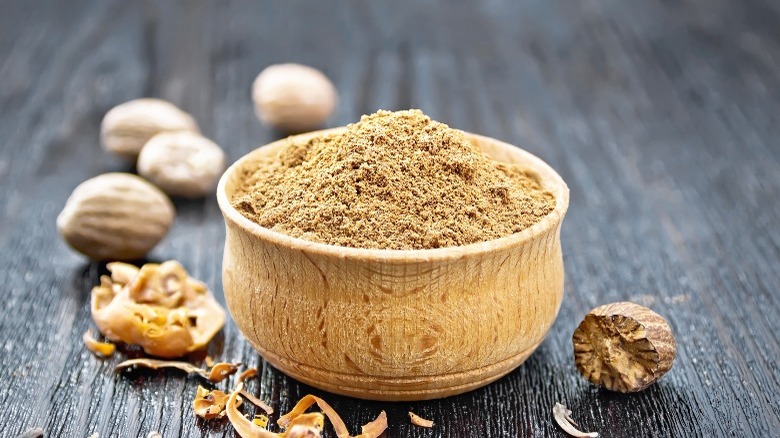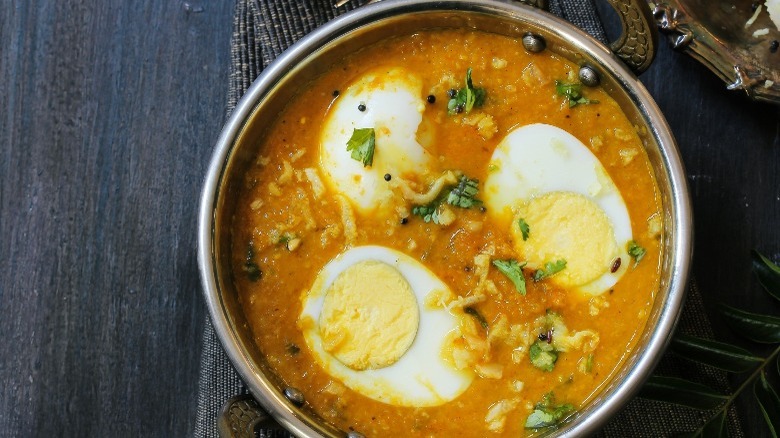13 Spices You Need To Use To Elevate Your Eggs
We may receive a commission on purchases made from links.
Have you ever eaten plain eggs without any seasoning at all? They can be pretty bland on their own. Sure, you can mix in things like cheese and milk, but still, meh. This doesn't mean that you should cut them out of your diet, though: The American Heart Association says that eggs are full of protein, Vitamin D, and other nutrients. If you're watching your cholesterol you can remove the yolks but unfortunately, some of the taste goes along with them.
Fortunately, eggs are a blank slate, so you can pile on multiple seasonings and elevate the taste to please most palates. Adding spices to recipes is an important part of healthy eating, and it's a great habit that you'll quickly get used to. Nutritious Life explains that pouring things like ketchup onto eggs can add unwanted sugar, so why do that when you can get delicious flavors (including sweetness) from spices? And the eggs don't just have to be boiled, scrambled, or poached because you can make egg hash, bake them into frittatas, and cook them into tacos — the options are endless. Move aside basic salt and pepper, because these eggs are ready for some major inspiration.
1. Himalayan black salt
Healthline posts that salt is found in most of the foods we eat, but consuming too much can increase blood pressure and cause other health problems. If this is a concern, ask your physician about limiting your intake. Otherwise, you can use it within reason and try some out-of-the-box salt to liven up your egg dishes. Two Kooks in the kitchen likes Kosher salt for everyday cooking and claims it isn't as salty as what's found in the average tabletop shaker. It can work well on eggs, but to knock them out of the park, you can sprinkle in black salt instead.
One Green Planet raves about black salt, which can also be dark purple or brownish. Look for containers labeled Himalayan black salt or kala namak. Its base is pink salt, which gets heated up. Then, Indian spices like harad fruit seeds are added in. Those seeds have sulfur and other minerals that create an unexpected, savory taste. Vegans like Himalayan salt because it adds egg flavor to vegan dishes without having to break open any shells.
2. Peppercorns
Pepper is good for you. A 2020 study by the National Library of Medicine concluded that this spice can help the body absorb iron efficiently, and Cleveland Clinic recommends swapping it out for salt to fight heart disease. But why stick with the plain version when there are other ones out there? If you're ready to elevate your pepper habit, start by investing in a pepper grinder. Eparé explains that pepper shakers filled with pre-ground pepper allow the spice to be exposed to oxidation, which takes away from the flavor. Pepper mills are easy to use, and also look nice sitting on your counter or table.
Peppercorns come in different colors besides basic black. Spice Jungle says that peppercorns are berry seeds that grow on the vines; the potent flavor comes from a chemical known as piperine. Green peppercorns are unripe and dried. You'll see them preserved in brine or packaged using other curing methods. Black peppercorns are green peppercorns that have been cooked, and the white versions are just berry seeds. We'll include pink peppercorns here too, even though they are not in the same category. ISpice explains that this spice comes from Brazilian pepper trees and while still peppery, that flavor is enhanced by fruity notes.
3. Paprika
Often paired with deviled eggs or goulash, paprika is a versatile spice that should have a place of prominence in your spice rack. McCormick Science Institute explains that this spice comes from capsicum annum (chili peppers), and the most common dried paprika has the familiar bright orange/reddish color — you get added flavor and color to elevate your eggs.
Like salt and pepper, paprika comes in different intensities so you can experiment with a few until you find one you like. Savory Spice shares options like Hungarian, sweet smoked Spanish, hot smoked Spanish, and California paprika. Hungarian and Sweet Smoked Spanish are the mildest, while the others pack more heat. Paprika is also easy to mix into spice blends, too. And if you think that the paprika in your cabinet has no flavor, it has probably been sitting there for too long. StillTasty claims that paprika can last up to four years when the containers have tight-fitting lids, but toss it sooner if it's past its prime.
4. Red pepper flakes
You say red pepper flakes, and she says crushed red pepper, but they are the same thing, according to SFGate. This lively spice puts a good kick in pizza and pasta dishes, but it is eye-opening on eggs, too. The capsaicin that it contains is thought to regulate diabetes and boost the immune system, and even level out upset stomachs. These health benefits should be enough to pique your interest, so what are red pepper flakes made from? Mexican Please says that the small bits are made from crushed, dried cayenne peppers. These aren't as hot as habaneros but are stronger than jalapeños and serranos.
Red pepper flakes might be too hot for your taste, but you can try using a little bit to enhance your eggs in a Turkish menemen dish. Try pouring just a few flakes into your hand instead of sprinkling them right on; you might love it. And if those pepper flakes taste off in any way, toss them. The Whole Portion writes that this spice can lose color and go bad, especially when exposed to moisture. As with other spices, check for expiration dates and stick to them.
5. Chili powder
Chili powder can contain cayenne pepper, but it's different from red pepper flakes, according to PepperScale. While chili flakes are often sprinkled on last-minute, chili powder usually gets incorporated into dishes to contribute to the overall flavor profile. Chili powder is also usually a spice blend rather than just pure dried chilis. You wouldn't want to substitute chili powder for red pepper flakes since they serve different purposes, but you can use both for a fiery taste (if you can handle it). Pure cayenne pepper powder is another option that will taste spicier than chili powder.
If your palate can't deal with spicy eggs for breakfast, feel free to use chili powder in eggy lunch and dinner dishes. Greengos Cantina likes adding this spice to deviled eggs and recommends switching it out with paprika. Another idea is to sautee onions, peppers, and mushrooms, and sprinkle them with chili powder. Add in beaten eggs and cook to the desired doneness for a Southwest-inspired scramble.
6. Cumin
And now for something different: cumin. Though it begins with the letter C, it's not related to chili powder or cayenne. The Spice House clarifies that cumin is related to parsley and caraway, adding that the spice is produced from the plant's seeds. And instead of tasting fiery, this spice can be described as kind of nutty and earthy. Vegetarians like cumin because the taste it adds can also be described as meaty. You'll notice the sharp, savory taste right away, and it can even be slightly bitter. This source likes mixing up cumin with allspice, nutmeg, sumac, cardamom, and some Greek oregano.
You have two choices with cumin — the seeds and ground cumin. SPICEography explains that ground cumin is not as strong because the process breaks down the spice (like grinding peppercorns). Always toast the seeds before using them, and use a spice grinder if you like. Another option is to fry the seeds, drain and save the oil, and cook your eggs in the oil.
7. Za'atar
The interesting thing about za'atar is that it's an herb as well as a spice mixture, according to Tyme Foods Za'atar. The herb can be compared to mild thyme, with an earthy, nutty, slightly tart flavor profile. A za'atar blend is a Middle Eastern spice concoction that adds saltiness, texture, and flavor to egg dishes. Though the ingredients can vary, you'll usually see things like oregano, toasted sesame and fennel seeds, cumin, and thyme.
Like the spiced oils you see served with bread at Italian restaurants, za'atar is often presented alongside oil and bread at Middle Eastern eateries. It has broken out of that box (bowl, actually), and people sprinkle it on salads and add it to sandwiches, and egg dishes. Feel free to experiment with za'atar by incorporating it into scrambled eggs. You can heat olive oil, add the spice or spice blend, wait a minute or so, and pour in the yolks and whites. Or, just spread some oil and za'atar on your toast or muffin and add cooked eggs for a great breakfast sandwich.
8. Sumac
Also native to the Middle East, edible sumac is not the same thing as poisonous sumac. So once you get past the name, this citrusy spice can be a great choice for egg elevation. Savory Experiments explains that the edible plant's berries get ground down into a powder and are sometimes used in za'atar blends. It can be hard to find ground sumac in stores, but you should be able to find it in specialty outlets and online.
The taste of sumac can be compared to lemons, so it has a somewhat sour and strong flavor. While that combination might seem off-putting at first, it might suit your palate. Lemon juice can even make your eggs fluffier if you add it in while cooking, but you might prefer sumac in the ground form to avoid wateriness. And to counteract sumac's strong flavor, you can add other spices like thyme to balance it out. Not really your thing? Lemon pepper can also add a citrusy flavor to eggs.
9. Everything bagel seasoning
While NPR claims that the history of everything bagels is a matter of some dispute, no one can argue that Trader Joe's Everything But The Bagel seasoning flies off the store's shelves. This is not the only place to buy the stuff either, as you can easily find similar versions online made by McCormick and other companies.
The Trader Joe's version is made with sea salt flakes plus poppy seeds, sesame seeds, onion, and garlic. You can also buy it in larger containers — you may find yourself using it on everything, and it doesn't cost that much. Each quarter teaspoon contains 80 grams of sodium and zero fat, carbs, and protein. The Whole Foods 365 version costs a little more, but the label specifies that the ingredients are organic. Either way, buy this spice in bulk and use it liberally on your eggs whenever you want to add a savory taste and some crunchy texture. It's the bomb.
10. Nutmeg
If you've baked with nutmeg, the recipe likely called for other spices like cinnamon, ginger, and sugar. What does nutmeg taste on like its own, though? Precision Nutrition's Encyclopedia of Food writes that this brown spice originates from Indonesian evergreen tree seeds. When used in the right way, nutmeg adds a distinctive, spicy sweetness. The spice is good on creamy egg dishes like eggs Florentine.
Nourish by WebMD sings the praises of nutmeg, a spice that's rich in antioxidants and fiber. You might not think of using it in eggs if you only use it in desserts, but it can really work. SFGate says that nutmeg can be incorporated into recipes and sprinkled on top of baked goods, but also claims that this spice enhances egg dishes. This source likes to sprinkle nutmeg on scrambled eggs and quiches and recommends doing so while the dishes are still nice and warm. Watch out though, because eating too much nutmeg can cause feelings of disorientation and anxiety. Stick to less than one tablespoon per serving and you'll be fine.
11. Garam masala
Continuing on a more aromatic vein, garam masala is an Indian spice blend and like za'atar, comes in different combinations. Look for ingredients like black pepper, cloves, coriander, chile, and nutmeg when shopping for these blends. Kids are Great Cooks posts that garam masala can also have fennel seeds and cardamom. Whichever combination you choose, you can count on getting toasted, complex flavors to make your eggs taste special.
Overall, garam masala warms and sweetens up foods and can also be used in desserts, veggies, soups, and egg curries. It can be harder to find in grocery stores that don't have international sections, but you can also make your own. Garam masala and eggs can be an acquired taste, so if you don't like it that way, use the spice in another dish. You'll see garam masala all over the menus in Indian restaurants, and this is a good way to try it if you're a first-timer.
12. Garlic
Garlic is related to onions and shallots and adds strength and character to egg dishes. The Webstaurant Store Blog writes that fresh garlic cloves can be roasted, minced, sliced, and pounded into pastes, and taste fresher than preserved or dried varieties. Granulated garlic is made from dried garlic that gets treated with a spice grinder. And then there's garlic powder, made from dehydrated, finely-ground cloves; add sodium and you have garlic salt. Just remember that garlic powder is more concentrated, and you can add the salt separately.
Fresh or granulated garlic tastes stronger and adds more texture than powders and salt. It also has known medicinal properties and can help ease cold and flu symptoms. To use fresh cloves, try a garlic press to make the skin removal and chopping easier. You can saute it in butter or oil and then add your eggs. Garlic salts and powders can be added during the cooking process or to finish the eggs.
13. Chives
They're technically an herb, but chives complement eggs beautifully and will take your creations to the next level. According to Almanac, these green plants grow from bulbs beneath the ground and come in two main varieties: common and garlic (Chinese). Common chives tend to taste more oniony than Chinese ones. You can use either variety of chives to add flavor to your eggs, but sample the chives first because some taste much stronger than others. You can change the flavor by sauteeing them in a bit of oil first — discard the oil and add the chives to the eggs. You can even crisp them up a little, but be careful not to burn them.
You can find packaged dried chives, but expect fresh ones to have better flavor. They are also easy to grow and can be frozen until you are ready to use them. Add fresh chives to scrambled eggs or sprinkle them generously atop cooked ones.
